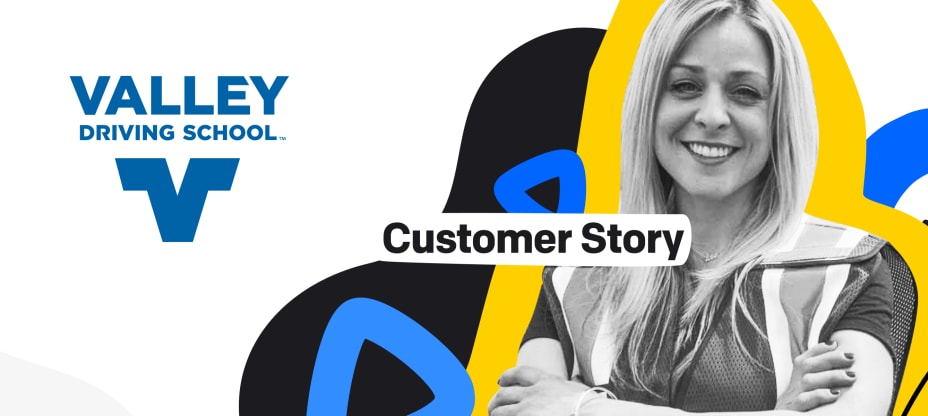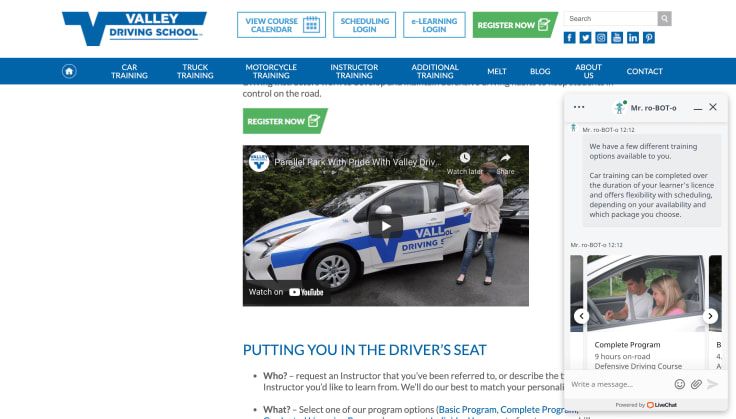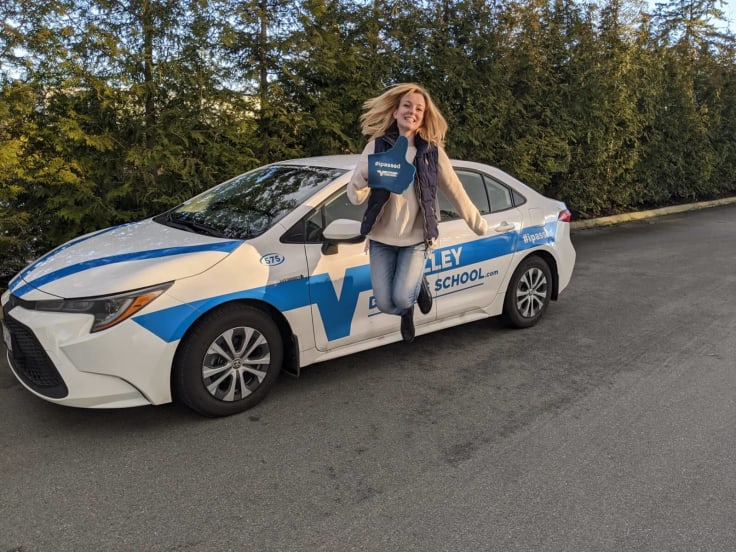Showing top 0 results 0 results found
Showing top 0 results 0 results found

By adding ChatBot to their website, Valley Driving School is now able to answer customer questions faster and more efficiently. Mr. ro-BOT-o, the company’s after-hours chatbot, solves visitors’ problems and delivers an exceptional full-service omnichannel experience.
☞ The brand story
☞ Valley Driving School's mission
☞ The customer service problem
☞ The chatbot solution
☞ Business results
☞ Tips for designing a great chatbot experience
The brand story
Valley Driving School is a driver training school with six locations based in Fraser Valley in the Lower Mainland of British Columbia, Canada. The company offers driver training for cars, trucks, buses, and motorcycles. Since 1955, the school has provided quality driver training to thousands of satisfied graduates.

Valley Driving School’s mission
The company’s goal is to help educate people to become safe and confident drivers. With a strong focus on road safety and accident prevention, their students learn how to pass road tests and embark on a new career as professional drivers or riders.
"For us, it’s exciting and an honor to be part of that journey with our students and assist them in achieving those milestones and goals."
Melissa Hannam, Director of Marketing at Valley Driving School
Would you like to grow your business with AI?
The customer service problem
At some point, Valley Driving School started getting a high volume of customer inquiries via email, especially when the office was closed. It became difficult to answer all the questions they received at speed. Every day, their customers needed support with their programs or rescheduling. With hundreds of inquiries a month, the school realized that a more immediate response to visitors' inquiries was needed. Not only were they missing sales opportunities during these off-hours, but they were also failing to meet the needs of existing clients as well.
Over the years, the school has tried various solutions to support its students in a timelier manner. Many of the options they looked at usually required a large commitment in the form of labor, which could get quite costly. From extending the office hours to starting an in-house call center, none of these potential solutions was the magic bullet when it came to serving customers round the clock while still being mindful of budget constraints.
The chatbot solution
The brand was looking for an omnichannel experience for its customers. They wanted to provide prompt, consistent, and accurate communication. LiveChat seemed like a good fit, and the company quickly achieved incredible success using it. After seeing ChatBot, an additional, automatic agent you can add to your LiveChat account, testing it out was a no-brainer. Both tools were the most user-friendly and reasonably priced solutions, considering all the features and reporting that were included.
Business results
Valley Driving started using ChatBot and LiveChat in December 2018. Currently, their chatbot has had over 12,500 conversations with website visitors, and they’re on track to exceed 6,000 conversations this year alone.

The school’s initial goal of responding to visitors faster and more efficiently has been met. Their chatbot has an average response time of three seconds. This allows the company to be available 24/7 for visitors to ask questions and get information. Staffing a contact center or a brick-and-mortar location 24/7 would be quite a financial undertaking, but ChatBot gives the school that 24/7 availability at a fraction of the cost.

Their website chatbot shares information about their products and services in real time. It answers regulatory questions, helps students schedule their training, and can transfer a chat to a live agent in a more complex situation. It’s a full-service omnichannel experience for visitors. Many clients have shared their satisfaction with the quality and speed of service they received. The company is delighted with its 94% customer satisfaction rate.
"All of my questions were answered. The bot performed much better than I was expecting."
"Amazing fast responses!"
"Helpful even though humans are not available."

Useful tips for designing a great chatbot experience
Melissa Hannam, Marketing Director at Valley Driving School, shared valuable insights with us about how you can make the most out of ChatBot.
Pro-tip 1: Take your time while building a chatbot
It can seem like a lot of work to enter all keywords, and information into ChatBot, but it’ll be worth it! It’s so rewarding seeing visitors ask multiple questions and be quickly provided with the correct information. It also helps share the workload with the live agents, ultimately saving on labor costs.
Pro-tip 2: Update your bot to adapt to changes
In 2018, we wouldn’t have imagined that one day the world would be struggling with a pandemic. However, in early 2020, COVID-19 was becoming a reality in our country, and visitors wanted to know what we were doing to prevent the spread. By adding a COVID-19 template and the potential keywords that would accompany it (covid-19, masks, face shield, etc.) we could provide up-to-date information on our efforts to curb the spread in our business and keep our clients and employees safe.
Pro-tip 3: Give your chatbot a personality
Choose a fun name for your chatbot or have it tell a joke if the situation allows it. For example, when our chatbot creates a ticket, for further follow-up, our chatbot says “The humans are getting their beauty sleep right now and boy do they need it! Please, leave your email address to have them follow up with you.” If a visitor swears at our chatbot, it acts a bit offended and says, “Well, I never! Don’t make me tell the humans! If you have a question or there is something I can help you with, please ask nicely.”
Pro-tip 4: Monitor your chatbot’s conversations
When a chatbot can’t answer a visitor’s question, this is an opportunity to correct the conversation for future visitors. We constantly review what went wrong by using Archives to determine how it could go right next time. We look for new keywords to add or clarify the information the chatbot is providing. There are many ways visitors can ask for a similar thing. Identifying these ways and teaching them to your chatbot improves its performance.
For example, in our industry, air brakes are required for most commercial licenses, but how visitors ask about air brakes can be quite varied. That’s why we’ve added spelling varieties, including common misspellings, such as air brake, air brakes, air break, etc. We also added varying terms that visitors might use to describe courses that involve the use of air brakes, including endorsement 15, class 5 air, air ticket, etc. Without continually reviewing the chatbot’s past conversations, we wouldn’t have known the wide variety of different terms that our clients are using to describe this specific training course. Adding these terms improves our chatbot, directs the visitor in the right direction, and helps to close the sale.



